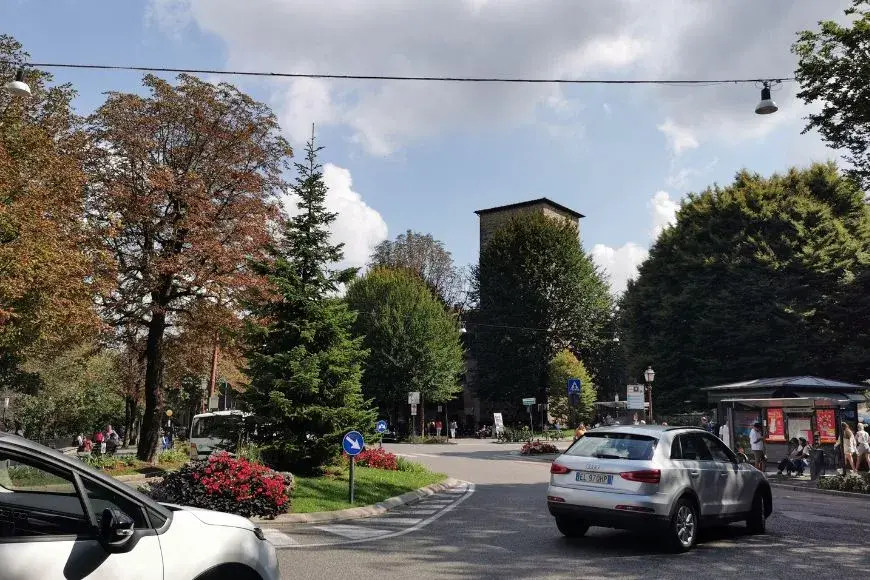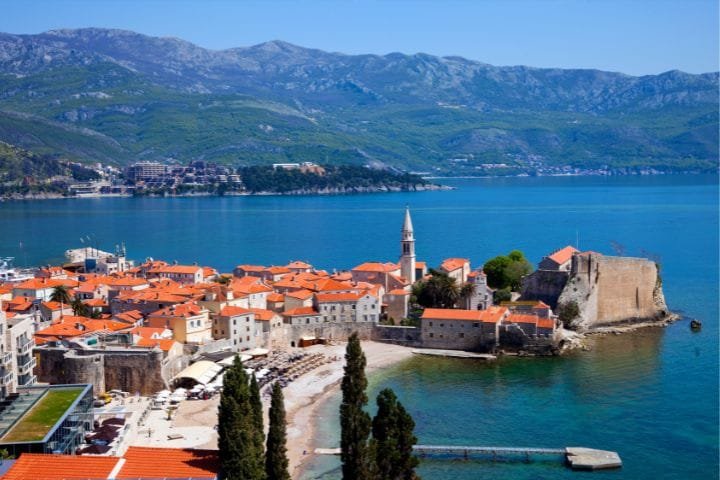The Ultimate European Road Trip Planning Checklist: Everything You Need

by Asia A. | Last Updated August 24, 2025

Did you know that 67% of European road trips experience preventable complications due to inadequate planning? I discovered this the hard way during my first adventure through the Balkans.
Picture this: after meticulously plotting a route from Croatia to Greece, I arrived at the Montenegrin border only to discover my International Driving Permit wasn’t recognized there. What followed was a frantic detour that cost me two days of my carefully planned itinerary!
That’s exactly why I’ve created this comprehensive European road trip planning checklist. From initial research a year in advance to final checks the day before departure, I’ll walk you through each critical planning phase.
Let’s get started on the road to your perfect European adventure!
12-6 Months Before: Early Planning Phase
The foundation of an unforgettable European road trip is laid months before you ever set foot on foreign soil. This early planning phase is crucial—it’s when you’ll make the big-picture decisions that shape your entire adventure. Let’s break down what you need to focus on during this period.

- Destination Research Methodology: Europe’s diversity means climate, crowds, and conditions vary dramatically depending on when and where you travel.
Start by considering: - Climate considerations by region: The Mediterranean coast basks in warm sunshine when the Nordic countries are still thawing out. For instance, July in Scandinavia offers pleasant temperatures of 65-75°F and extended daylight hours, perfect for maximizing sightseeing, while the same month in Southern Spain might bring uncomfortable heat of 95°F or higher, limiting daytime activities.
- Peak vs. off-peak timing: August finds the Côte d’Azur packed with vacationing Europeans and prices at their highest, while a May visit offers similar weather with half the crowds and significantly lower accommodation rates. I’ve found May and June, as well as September and October, to be the sweet spots for balancing good weather with lighter crowds across most of Europe.
- Political stability and safety: Check government travel advisories for your planned destinations. While most of Europe is remarkably safe, regional events can impact travel plans. The UK Foreign Office and US State Department websites provide regularly updated travel information specific to each country.
- Local events and festivals: Sometimes, planning around a particular event, like Munich’s Oktoberfest or Seville’s Feria de Abril, can make it the centerpiece of your entire trip. Research regional calendars to either embrace these cultural highlights or avoid the accompanying crowds and price increases.
- Route Planning Fundamentals: With destinations in mind, it’s time to map out your journey.
- Custom route creation: Google My Maps is my go-to tool for plotting the perfect European route. Create a new map, drop pins on your must-visit destinations, and then connect the dots with driving routes.
I always color-code pins by priority (must-see vs. nice-to-have) to help with later decision-making.
- Realistic driving calculations: Use the formula: Google Maps estimated time + 25% for a more realistic expectation. That 3-hour drive from Barcelona to Valencia? Allow 4 hours to account for stops, traffic, and the generally slower pace of European driving.
- Scenic route identification: Websites like ViaMichelin and the Michelin Green Guides specifically highlight scenic routes worth taking. Unlike apps that prioritize speed, these resources help you discover the stunning coastal cliffs of Ireland’s Wild Atlantic Way or the breathtaking mountain passes of the Alps.
- Border crossing logistics: While the Schengen Area has eliminated many formal checkpoints, prepare for potential delays at borders like Croatia/Slovenia or any non-EU transitions. Some crossings can add 30+ minutes during peak season, so factor this into your driving day.
Documentation Preparation Timeline
Now’s the time to tackle the paperwork that makes your trip possible:
- Passport validity requirements: Double-check that your passport will remain valid for at least six months beyond your planned return date. Many European countries won’t admit travelers with passports expiring sooner, regardless of the actual length of your stay.
- Country-specific visa requirements: EU nations typically allow US citizens visits up to 90 days without a visa, but non-EU European destinations like Russia and Turkey have their own requirements. The Schengen visa calculator can help ensure you don’t exceed your allowed 90 days within the 26-country Schengen zone.

- International Driving Permit: This UN-regulated document translates your license information into multiple languages. Critically, different European countries have different IDP requirements. France, Italy, and Germany technically require them, while the UK and Ireland don’t. Apply through AAA or similar services in your home country at least 6 weeks before departure.
- Vehicle documentation needs: If bringing your own vehicle, research the Green Card insurance system, vehicle registration translations, and any required emissions stickers well in advance. For UK drivers post-Brexit, requirements have become more complex when bringing personal vehicles to the continent.
With these early planning elements in place, you’ve created a solid framework for your European road adventure. The destinations you choose now and the routes you begin mapping will set the stage for the more detailed planning phases to come.
6-3 Months Before: Booking Phase
With your route mapped out, it’s time to make the key bookings that will transform your plan into reality. This 3-6 month window is critical for securing the best options before they disappear.
Vehicle Considerations
Your choice of vehicle can make or break your European road trip experience.
- When deciding between renting and bringing your own car, calculate the rental costs against ferry fees and additional insurance for your personal vehicle. For rentals, I’ve found that midsize vehicles offer the best balance—small enough for medieval town centers but comfortable for long drives.
- Remember that approximately 80% of European rentals are manual transmission. If you need automatic, book early and expect to pay 20-30% more. One-way rentals between countries can incur fees of €150-500, so consider a circular route when possible.
- For electric vehicle enthusiasts, research charging infrastructure varies dramatically—Norway and the Netherlands offer excellent coverage, while southern and eastern European countries may present challenges on rural routes.
Accommodation Strategy
- Hotels.com and Airbnb offer the widest European coverage but don’t overlook regional specialists like Sawday’s for unique stays. I recommend securing accommodations with free cancellation, especially for high-season travel.
- Always verify parking availability—particularly in historic centers where parking can add €20-30 daily to your budget.
- Consider strategically placing your overnight stays to minimize driving fatigue; I aim for no more than 4 hours of driving between overnight stops.

Insurance Planning
- European vehicle insurance requirements vary by country. The minimum third-party liability coverage is mandatory, but I strongly recommend full coverage for international road trips. Decline rental company insurance only if your credit card or travel insurance provides equivalent protection.
- Verify your health insurance coverage abroad—many policies offer limited international coverage. Consider supplemental travel insurance that specifically covers road trip contingencies like vehicle breakdowns or trip interruptions.
- Create a digital insurance folder containing policy numbers, coverage details, and emergency contact information for all insurance policies. Store copies both on your phone and in cloud storage for access, regardless of connectivity.
With these booking decisions made, you’ll have secured the essentials for your journey while maintaining flexibility for the detailed planning still to come.
4-2 Weeks Before: Final Preparations
With your departure date approaching, it’s time to finalize the details that will transform your carefully crafted plan into a smooth experience.
Detailed Itinerary Finalization
The perfect European road trip balances ambition with reality:
- Daily driving limits: European driving takes longer than you might expect. I recommend limiting daily driving to 3-4 hours (200-250 km) to avoid exhaustion and allow for spontaneous discoveries.
- Strategic stops: Research viewpoints and rest areas in advance—France’s aires offer excellent facilities, while Italy’s auto grill locations provide authentic food experiences worth building into your schedule. The Raster app identifies scenic overlooks across most of Europe.
- Pre-booking necessities: Many popular European attractions now require timed entry reservations, often selling out weeks in advance. Priority book tickets for must-see sites like Barcelona’s Sagrada Familia, Florence’s Uffizi Gallery, and Amsterdam’s Anne Frank House to avoid disappointment.
- Meal strategies: Research regional specialties and create a food bucket list. For budget management, plan to alternate between picnic lunches (European supermarkets offer excellent prepared foods) and local restaurants. Apps like TheFork offer discounts at restaurants across Europe when booked in advance.
- Buffer allocation: For every 7-10 days of travel, add at least one buffer day with no fixed plans. These flexible days allow for unexpected discoveries, weather delays, or simply catching your breath, often becoming the most memorable parts of your journey.

Vehicle Specifics
Different European countries have different vehicle requirements:
- Safety equipment: Compile a checklist by country. France requires warning triangles, reflective vests for each passenger, and a breathalyzer. Spain mandates two warning triangles and spare bulbs. Germany requires a first aid kit. Most rental companies provide this equipment, but verify it in advance.
- Road sign familiarization: European signs differ significantly from North American ones. Download the “European Road Signs” app for quick reference, particularly for the unusual circular prohibition signs common throughout the continent.
- Emergency contacts: Create a country-by-country list of emergency numbers. While 112 works throughout Europe for emergencies, roadside assistance varies: 17 in France, 91 in Italy, and ADAC in Germany. Your rental company will provide their specific assistance numbers.
- Low-emission zones: Many European cities restrict vehicle access based on emissions standards. Research requirements for cities on your itinerary—Paris, London, and most German cities require pre-registration and sometimes payment. Rental vehicles typically comply with standards but still need registration.
- Winter considerations: If traveling between November and April in mountainous or northern regions, verify winter equipment requirements. Austria, Germany, and much of Scandinavia mandate winter tires during these months, while Alpine passes may require snow chains.
Financial Preparations
Smart money management prevents costly complications:
- Exchange strategies: Avoid airport currency exchanges with their poor rates. Instead, use bank ATMs in Europe for cash withdrawals and credit cards for most purchases. Consider ordering a small amount of starter euros from your home bank for immediate needs upon arrival.
- Card notifications: Notify all credit and debit card issuers of your destinations and travel dates to prevent fraud blocks. Bring at least two different card networks (Visa/Mastercard) as backup options.
- Cash requirements: While Scandinavia and the Netherlands function almost entirely on cards, countries like Germany, Italy, and much of Eastern Europe still rely heavily on cash. Research typical cash usage by destination and carry appropriate amounts.
- Budget breakdown: Create a daily spending estimate that includes fuel (€60-100 every 500km, depending on vehicle), tolls (€10-25 daily in toll-heavy countries), parking (€15-30 in cities), meals, and attractions. Build in a 15% contingency for unexpected expenses.
- Emergency access: Distribute your funds across multiple accounts and cards. Establish a dedicated “emergency fund” equivalent to 3-5 days of expenses, accessible through a separate card stored apart from your primary wallet as insurance against theft or loss.
These final preparations transform your European road trip from a hopeful plan into an executable adventure, helping you anticipate challenges before they arise.

1 Week Before: Ready to Go
The countdown has begun! With just one week until departure, focus on finalizing the personal preparations that will ensure both comfort on the road and peace of mind while away from home.
Packing Essentials
Strategic packing makes all the difference on a European road trip:
- Regional clothing strategy: Pack for the climate zones you’ll visit, not just the season. Summer in the Mediterranean requires lightweight, breathable clothing, while Alpine regions need layers even in August. My versatility formula: three bottoms, five tops, one light jacket, one warmer layer, and laundry options every 4-5 days.
- Power solutions: European outlets use 220V with rounded two-prong plugs (Type C). Bring a multi-country adapter with USB ports, and check that your electronics are dual-voltage (most modern devices are). Vehicle power is critical, too—pack a 12V adapter with multiple USB outlets to keep devices charged on the road.
- Comfort considerations: European road trips often involve longer driving sessions than you might be accustomed to at home. A small travel pillow, light blanket, and reusable water bottle make a world of difference during long stretches. Consider a seat cushion for older European vehicles with firmer seats.
- Entertainment planning: Download offline entertainment before departure—audiobooks, podcasts, and regional playlists enhance the journey. For passengers, load tablets with content and bring headphones. Don’t forget old-school options like travel games for areas with spotty connectivity.
- Space optimization: European cars typically offer less storage than American vehicles. Use packing cubes to compress clothing, and opt for soft-sided luggage that conforms to irregular trunk spaces. Pack the car strategically—keep daily essentials accessible rather than buried under suitcases.
Final Documentation Check
Proper document management prevents border-crossing headaches:
- Digital backup system: Create a secure cloud folder containing scans of all critical documents: passports, driver’s licenses, insurance cards, rental agreements, accommodation confirmations, and attraction tickets. Share access with a trusted contact at home.
- Physical organization: Use a dedicated travel document organizer with sections for different document types. Keep this with you at all times, not in your checked luggage or vehicle when unattended.
- Emergency redundancy: Distribute document copies strategically—keep digital copies on your phone, paper copies separate from originals, and leave a set with your emergency contact at home. Email yourself critical confirmation numbers and reservation details.
- Validity verification: Check expiration dates on credit cards, car insurance, International Driving Permit, and any pre-booked attraction tickets. Verify that your passport meets the six-month validity rule for all countries on your itinerary.
- Emergency information: Create a wallet-sized card with emergency contacts, blood type, allergies, and medical conditions translated into the languages of the countries you’ll visit. Include your accommodation details and embassy contact information.
Home Preparation
Proper home management allows you to focus on your adventure:
- Mail management: Set up USPS mail hold or forwarding services. For packages, use delivery management tools or arrange with neighbors for collection. Consider temporary subscription pauses for regular deliveries.
- Security setup: Program light timers, verify alarm systems, and adjust smart home settings. Notify trusted neighbors of your absence and consider doorbell cameras with smartphone alerts for additional monitoring.
- Emergency contacts: Designate a primary contact with a house key who can handle unexpected issues. Provide them with your itinerary, accommodation details, and property information (where to find water shut-offs, etc.).
- Pet arrangements: Finalize pet care—whether boarding, in-home sitting, or care by friends. Leave detailed care instructions, veterinary contact information, and enough supplies for several days beyond your planned return.
- Maintenance scheduling: Arrange for lawn care or snow removal as needed. Consider the season—summer might require plant watering systems, while winter demands freeze-prevention measures in cold climates.
With these final preparations complete, you’ve set the stage for both a worry-free departure and a comfortable journey. Now, you can focus on the excitement of the adventure ahead rather than nagging concerns about forgotten details.

Day Before Departure
The final 24 hours before your European adventure begins are crucial for ensuring a smooth start to your journey. Take time to complete these last-minute preparations that will help you depart with confidence and peace of mind.
Final Vehicle Checks
Whether using your own vehicle or picking up a rental, these checks are essential:
- Tire pressure optimization: Verify all tires (including the spare) are inflated to the manufacturer’s recommended pressure. Properly inflated tires can improve fuel economy by up to 3%.
- Fluid verification: Check engine oil, coolant, windshield washer fluid, and brake fluid levels. For rental cars, familiarize yourself with how to check these levels before you’re on the road.
- Essential tools inventory: Confirm your vehicle contains all required safety equipment for your route’s countries. For rentals, verify that warning triangles, reflective vests, and first aid kits are present before leaving the rental location.
- Spare tire inspection: Locate and inspect the spare tire, jack, and lug wrench. Understand how to access and use them – different European vehicle models often have unique spare tire storage and changing procedures.
- Vehicle cleanliness: A clean car improves visibility and makes the journey more pleasant.
Technology Readiness
Your tech stack is your lifeline on unfamiliar roads:
- Full charging: Ensure all devices – phones, tablets, cameras, power banks, Bluetooth headphones – are 100% charged and ready. This provides a confidence buffer for your first day when you might not immediately find convenient charging options.
- App functionality testing: Open and test each critical app you’ll rely on – navigation, translation, accommodation, and banking apps. Verify they’re updated and functioning properly, especially after downloading offline content, which sometimes causes glitches.
- Offline content confirmation: Manually verify that offline maps, translation packs, and accommodation details have been successfully downloaded. Open Google Maps in airplane mode to confirm your route areas are available offline.
- Camera preparation: Format memory cards, charge batteries, and organize camera gear for quick access to capture those unexpected moments that inevitably arise on European backroads.
- First-day navigation: Pre-program your first destination into your navigation system. Familiarize yourself with the route, noting any complicated intersections or transitions. Set your departure location as “home” in your navigation app for easy return directions later.
Mental Preparation
Your mindset significantly impacts your journey’s start:
- Sleep prioritization: Aim for 7-8 hours of sleep the night before departure. Resist the temptation of last-minute packing marathons that compromise your rest. A well-rested driver is a safer driver, especially when navigating unfamiliar roads.
- Jet lag strategy: If flying to your starting point, begin adjusting your sleep schedule days before departure. Upon arrival, stay awake until a reasonable local bedtime to accelerate adjustment. For eastbound flights to Europe, consider an early night before travel day.
- Route familiarization: Review your first day’s route one final time, noting key highway transitions and potential confusion points. Mentally rehearse the first few turns from your starting location when navigation may be most disorienting.
- Departure timing: Plan to leave during off-peak traffic periods – typically mid-morning after rush hour. Check local traffic apps for your departure city to identify optimal departure windows.
- Meal planning: Prepare simple, protein-rich meals for your departure day to maintain consistent energy levels. Pack easily accessible snacks and water for your first driving stretch so you’re not immediately searching for food in an unfamiliar area.
With these final preparations complete, you can rest easy knowing you’ve set yourself up for the best possible start to your European road adventure. Tomorrow, the journey begins!
Conclusion
Careful planning truly makes the difference between a European road trip filled with delightful discoveries and one derailed by preventable complications.
Following this timeline-based approach has transformed my own journeys, like my recent 3-week adventure from Berlin to Budapest, where advanced research on Hungarian vignette requirements saved me from a €150 fine that many travelers unknowingly incur.
While detailed planning creates a solid foundation, remember that some of Europe’s greatest pleasures come from spontaneity. The carefully researched itinerary that led me to Slovenia’s Lake Bled also gave me the confidence to spend an unplanned day exploring a charming village I spotted from the road.
For additional planning support, check out our companion guides on:
- Top Book Guided Road Trips in Europe
- How to Plan the Perfect One-Month Europe Road Trip
- 25 Essential Car Comfort Accessories for Long Drives
Download Checklist
💬 We’d love to hear from you!
Have questions, tips, or personal travel stories to share? Drop them in the comments below — your insights help fellow travelers plan their adventures too.












